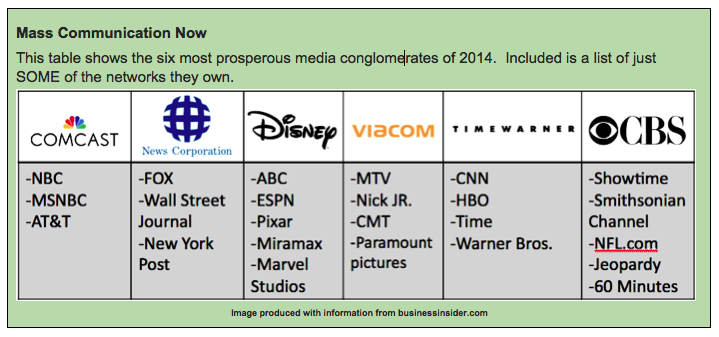
Nevertheless, most mass communication comes from large organizations that influence culture on a large scale. Schramm refers to this as a “working group organizer” (115). Today the working groups that control most mass communication are large conglomerates such as Viacom, NewsCorp, Disney, ComCast, Time Warner, and CBS. In 2012, these conglomerates controlled 90% of American Media and mergers continue to consolidate ownership even more. An example of an attempt at such a takeover of power occurred throughout 2014 with Comcast and Time Warner pursuing a merger for $45 billion. If successful, this will be one of the biggest mergers in history.
Remember our definition of communication study: “who says what, through what channels (media) of communication, to whom, [and] what will be the results” (Smith, Lasswell & Casey 121)? When examining mass communication, we are interested in who has control over what content, for what audience, using what medium, and what are the results? Media critic Robert McChesney said we should be worried about the increasingly concentrated control of mass communication that results when just a handful of large organizations control most mass communication, “The implications for political democracy, by any standard, are troubling” (23). When interviewed, Ben Bagdikian, media critic and former Dean of the Graduate School of Journalism, University of California, Berkeley, cautiously pointed out that over the past two decades, major media outlets went from being owned by 50 corporations to just five (WGBH/Frontline). Both McChesney and Bagdikian warn about the implications of having so few organizations controlling the majority of our information and communication. Perhaps this is the reason new media outlets like Instagram, YouTube, and Facebook have consistently grown in popularity as they offer alternative voices to the large corporations that control most mass communication.

Mass communication continues to become more integrated into our lives at an increasingly rapid pace. This “metamorphosis” is representative by the convergence occurring (Fidler) between ourselves and technology, where we are not as distanced from mass communication as in the past. Increasingly, we have more opportunities to use mediated communication to fulfill interpersonal and social needs. O’Sullivan refers to this new use of mass communication to foster our personal lives as “masspersonal communication” where (a) traditional mass communication channels are used for interpersonal communication, (b) traditionally interpersonal communication channels are used for mass communication, and (c) traditional mass communication and traditional interpersonal communication occur simultaneously.” Over time, more and more overlap occurs. “Innovations in communication technologies have begun to make the barriers between mass and interpersonal communication theory more permeable than ever” (O’Sullivan). Sites such as Facebook, Twitter, Vine, Snapchat, and Instagram are great examples of new mass communication platforms we use to develop and maintain interpersonal relationships.
As more mass communication mediums develop, Marshall McLuhan states that we can understand media as either hot or cold depending on the amount of information available to the user, as well as the degree of participation. A hot medium “extends one single sense in high definition” (McCluhan 22). Examples of hot media include photographs or radio because the message is mostly interpreted using one sense and requires little participation by participants. An audience is more passive with hot media because there is less to filter. Television is considered a cold medium because of the large amount of multisensory information. Berg Nellis states “Virtual reality, the simulation of actual environment complete with tactile sensory input, might be the extreme in cold media…This and other cutting edge technologies seem to point to increasingly cold media as we move into the digital communication future” (256). Think about online video games, such as the military sci-fi game, Halo. Games like this can be played in teams but the players do not necessarily have to be in close proximity. Simply by logging onto the server gamers can connect, interact, communicate through microphones and play as a team. These games have become so involved and realistic that they represent cold mediums because of the vast amount of sensory input and participation they require.
Perhaps we are turning into a “global village” through our interdependence with mass communication. Suddenly, “across the ocean” has become “around the corner.” McLuhan predicted this would happen because of mass communication’s ability to unify people around the globe. Are you a player in what Hagermas calls the “public sphere” that mass communication creates by posting information about yourself on public sites? If so, be careful about what you post about yourself, or allow others to “tag” you in, as many employers are googling potential employees to look into their personal lives before making decisions about hiring them. As we continue our discussion of mass communication we want to note that mass communication does not include every communication technology. As our definition states, mass communication is communication that potentially reaches large audiences.
Candela Citations
- Survey of Communication Study. Authored by: Scott T Paynton and Linda K Hahn. Provided by: Humboldt State University. Located at: https://en.wikibooks.org/wiki/Survey_of_Communication_Study. License: CC BY-SA: Attribution-ShareAlike
- Image of Mass Communication definition. Authored by: Spaynton. Located at: https://commons.wikimedia.org/wiki/File:Masscomm.png. License: CC BY-SA: Attribution-ShareAlike
- Image of Mass Communications Now. Authored by: Spaynton. Located at: https://commons.wikimedia.org/wiki/File:Corporationsownmedia.png. License: CC BY-SA: Attribution-ShareAlike